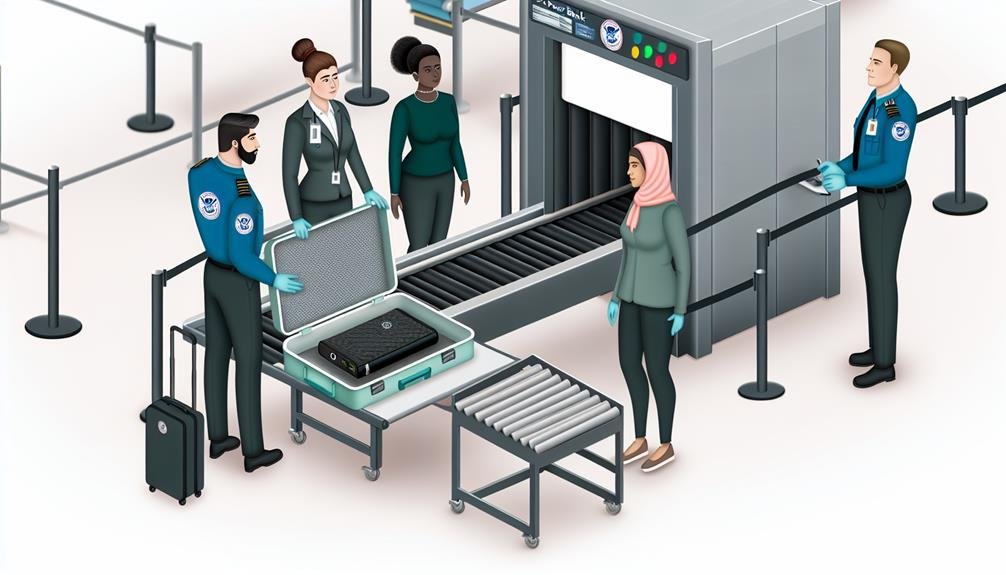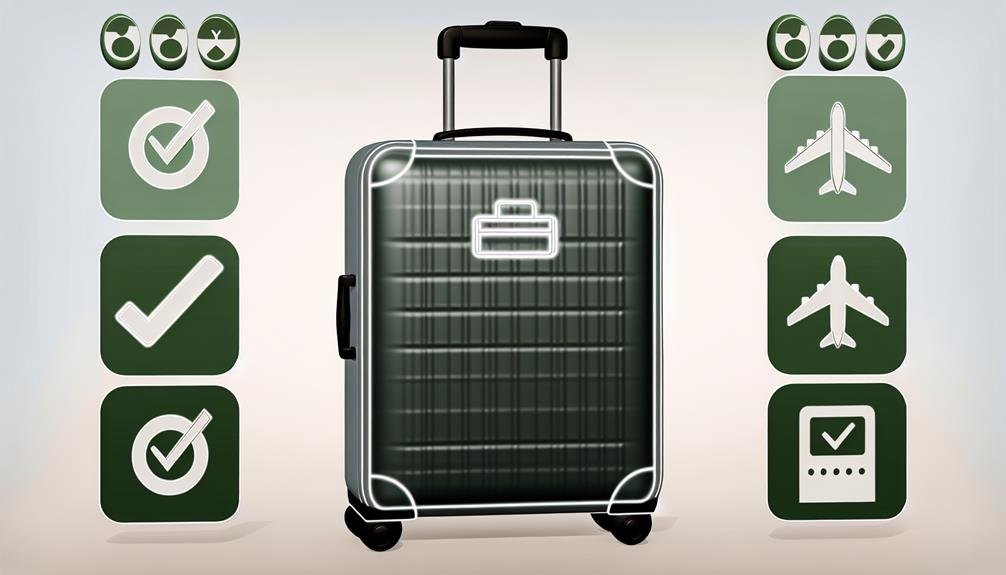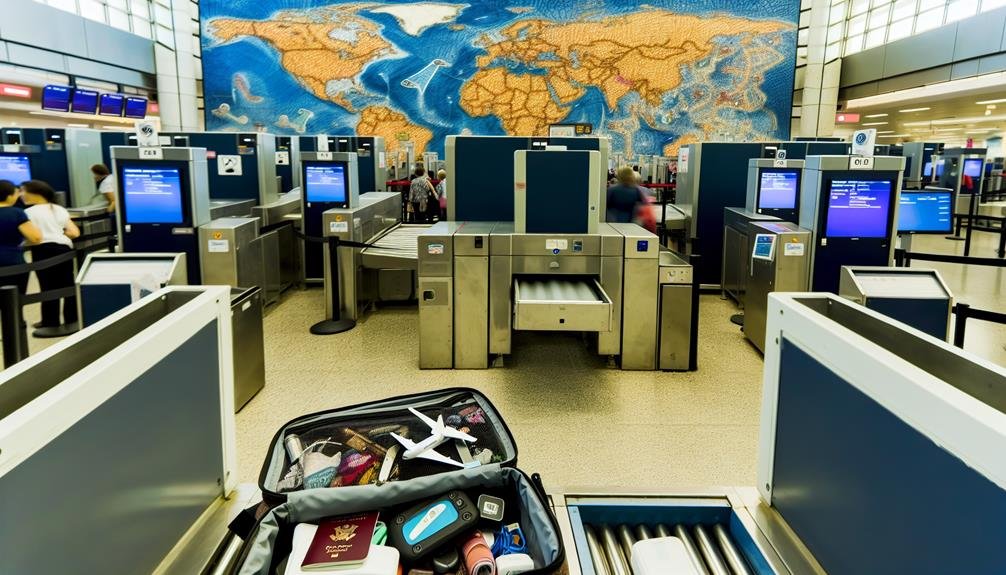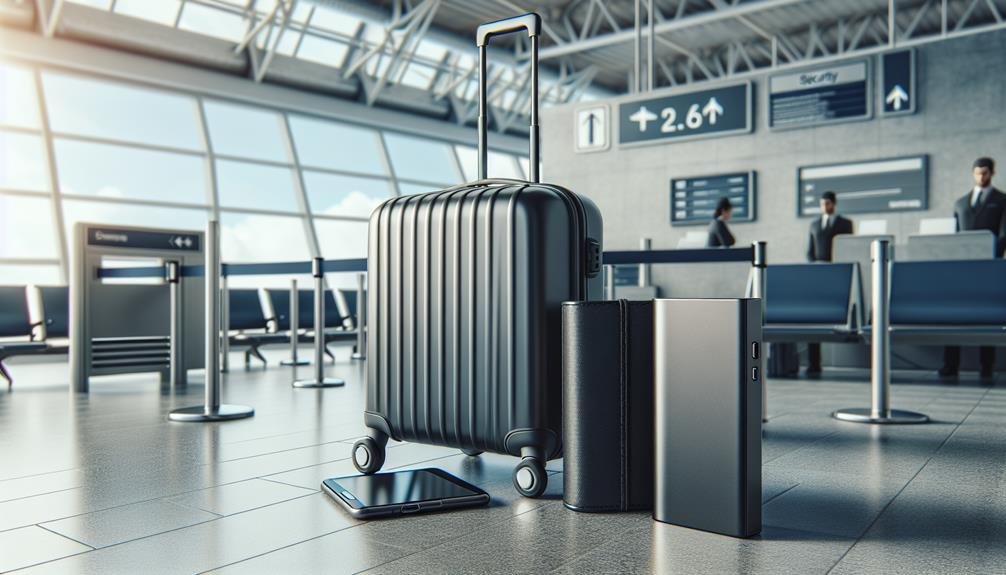Yes, you can carry power banks in your carry-on, but there are rules. Power banks under 100Wh don't need prior approval. For those between 100Wh and 160Wh, you'll need the airline's approval. Anything over 160Wh is generally prohibited. Always keep your power bank accessible for security checks and use only approved cables. Never pack power banks in checked luggage, as it's not allowed. Make sure to check specific airline policies for a hassle-free experience. There's much more involved in ensuring you follow all safety and packing guidelines for a smooth trip.
Airline Regulations

Understanding airline regulations is important when you're packing a power bank in your carry-on. The guidelines are set to guarantee safety and prevent any hazards during the flight. Most airlines have strict battery restrictions, primarily because lithium-ion batteries, commonly found in power banks, can pose a fire risk if not handled correctly. To comply with these regulations, you need to be aware of the specific rules your airline enforces.
During security checks, you'll need to remove your power bank from your bag, similar to how you handle laptops and other electronic devices. This allows security personnel to inspect it separately, ensuring it meets the airline's safety standards. It's crucial that your power bank is easily accessible and fully charged so it can be tested if necessary.
When it comes to charging options, make sure your power bank is intended for portable devices and adheres to the airline's guidelines. Some airlines restrict the use of certain types of power banks during the flight. Always check the airline's website or contact their customer service for the most up-to-date information. Following these steps not only guarantees your own safety but also that of your fellow passengers.
Power Bank Capacity Limits
When packing your carry-on, it's crucial to know the capacity limits for power banks as airlines often impose restrictions based on their watt-hour (Wh) rating. Understanding these capacity restrictions guarantees you're compliant with airline policies and TSA regulations.
The general rule for most airlines is that power banks under 100Wh can be carried without prior approval. For those between 100Wh and 160Wh, you can bring them, but you'll need the airline's authorization. Power banks over 160Wh are usually prohibited in carry-on luggage. This helps uphold safety and prevents potential hazards related to high-capacity batteries.
Here's a quick reference guide:
| Capacity (Wh) | Airline Policy |
|---|---|
| < 100Wh | Allowed without prior approval |
| 100Wh – 160Wh | Requires airline permission |
| > 160Wh | Not allowed in carry-on luggage |
It's also worth noting that the TSA has specific charging limits to guarantee safety. Always check the airline's guidelines before your trip, as policies can vary. By adhering to these regulations, you can travel with peace of mind, knowing your power bank won't cause any issues at security checkpoints or on the plane.
Safety Guidelines

To safeguard your power bank is safe for air travel, adhere to these critical safety guidelines. First, verify your power bank's capacity doesn't exceed airline and TSA regulations, typically capped at 100Wh without prior approval. Power banks must always be carried in your carry-on luggage, not in checked bags. This rule minimizes risk in case of overheating or fire.
During the security check, your power bank should be easily accessible. Place it in a separate bin, much like your laptop, to expedite the process and comply with security protocols. Keep an eye on battery life; older batteries are more prone to malfunctions. If your power bank shows signs of wear, such as swelling or reduced battery life, replace it before traveling.
Additionally, use only manufacturer-approved cables and chargers to avoid overcharging or short-circuiting. Disconnect your power bank when it's fully charged to prevent overheating. Never charge your power bank unattended, particularly in confined spaces like an aircraft. Following these guidelines will secure your power bank is safe and compliant, reducing any risk to yourself and others while traveling. Always prioritize safety to make your journey as smooth as possible.
Packing Tips
For best convenience and safety, always pack your power bank in a location within your carry-on where it's easily accessible. This guarantees you can quickly retrieve it during security checks or in-flight. To maximize your travel experience, consider these essential organization tips:
- Compartmentalize Your Items: Use a dedicated pocket or section in your bag for your power bank and charging cables. This helps you stay organized and prevents tangling or damage.
- Label Your Cables: Clearly label your charging cables to avoid confusion and make sure you grab the right one when needed. This simple step can save you time and frustration.
- Monitor Battery Life: Keep an eye on your power bank's battery life. Fully charge your portable charger before your trip to make certain you have ample power for your devices.
International Travel Rules

Navigating international travel rules for carrying power banks helps you avoid any unexpected hassles at airport security checks. Adhering to these regulations is essential for a smooth journey. Most airlines allow power banks in your carry-on, but not in checked luggage due to fire risks associated with lithium-ion batteries. Typically, power banks with a capacity of up to 100Wh are permitted without prior approval. Anything between 100Wh and 160Wh requires airline approval, while those over 160Wh are generally prohibited.
During security checks, make sure your power bank is easily accessible. Place it in a bin for separate screening. Different countries and airlines might have varying airport restrictions, so always verify specifics before you fly.
When selecting a power bank for international travel, consider charging options and device compatibility. Multi-port power banks that support various devices are advantageous. Moreover, confirm that your power bank is compliant with international safety standards, such as UN38.3, which tests for safe air transport.
Lastly, always carry documentation of your power bank's capacity and certification. This precaution helps mitigate misunderstandings during security checks and ensures a hassle-free travel experience.
Frequently Asked Questions
Can I Use My Power Bank During the Flight?
You can't use your power bank during the flight due to in-flight charging restrictions. For power bank safety, it's best to stow it away and enjoy the aerial voyage like a true air traveler from yesteryears.
Are There Restrictions on the Brand of Power Bank I Can Carry?
Yes, there are brand restrictions and size limitations for power banks on flights. Confirm your power bank meets airline safety standards. Typically, power banks under 100Wh are allowed, but always check your airline's specific guidelines.
What Happens if My Power Bank Is Confiscated?
It's quite a coincidence you're asking about confiscation. If your power bank is taken by airport security, you'll lose your electronic devices' backup power, and you won't get it back. Always check regulations to guarantee safety.
Can I Charge My Devices With the Power Bank at the Airport?
Yes, you can charge your devices with the power bank at the airport. However, utilizing charging stations might be safer and more reliable, ensuring your power bank's battery life is preserved for in-flight emergencies.
How Should I Declare My Power Bank at Security Checkpoints?
Did you know 90% of travelers carry power banks? At security checkpoints, declare your power bank by showing it to the agent. Follow power bank usage guidelines and flight restrictions to guarantee safety and compliance.



